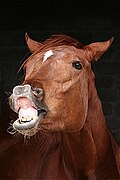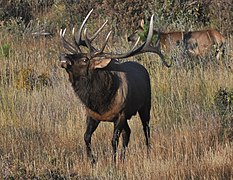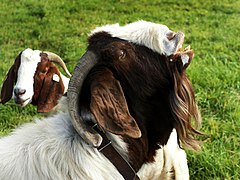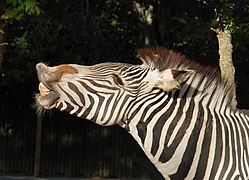Flehmen response
-
Flehmen response in a horse
-
Flehmen response in a Sumatran tiger
-
Flehmen response in a tapir
-
Flehmen response in an elk
-
Flehmen response in a goat
-
Flehmen response in a zebra
The flehmen response (/ˈfleɪmən/; from German flehmen, to bare the upper teeth, and Upper Saxon German flemmen, to look spiteful), also called the flehmen position, flehmen reaction, flehmen grimace, flehming, or flehmening, is a behavior in which an animal curls back its upper lip exposing its front teeth, inhales with the nostrils usually closed, and then often holds this position for several seconds.[1] It may be performed over a sight or substance of particular interest to the animal, or may be performed with the neck stretched and the head held high in the air.
Flehmen is performed by a wide range of
Etymology
The word originates from the German verb flehmen, to bare the upper teeth. It comes from the Upper Saxon German flemmen, "to look spiteful".[2] The word was introduced in 1930 by Karl Max Schneider, director of the Leipzig zoo and an authority on big cats in captivity.[3][4]
Discovery
The flehmen response was first described by
Description
This response is characterized by the animal curling back its top lip exposing the front teeth and gums, then inhaling and holding the posture for several seconds.
Mechanism
The flehmen response draws air into the
Chemical cues
The chemical cue obtained by an animal exhibiting the flehmen response is the presence of a non-volatile
Function
An animal may perform the flehmen response when investigating sites of particular interest, or perhaps (more generally) odors or tastes.
Intra-species communication
The primary function of the flehmen response is intra-species communication. By transferring air containing pheromones and other scents to the
- Identifying reproductive status – male individuals commonly use the flehmen response as an olfactory mechanism for identifying the reproductive state of females of the same species based on estrus when the ewes are sexually receptive.[11]
- Reproductive synchrony – flehmen behavior also plays a role in copulation synchronization.[13]
- Post-parturition – in horses, mares commonly show a peak in flehmen response during the first few hours after giving birth. Smelling the newborn foal and the amniotic fluids associated with birth often produces the reaction.[14]
- Immature animals – in young horses, both colts (males) and fillies (females) exhibit flehmen behavior toward other conspecifics with neither sex performing the behavior more than the other.[1] However, it has been reported that young colts flehmen up to five times more frequently than fillies, and fillies flehmen more frequently than mature mares.[14][contradictory] Young elephants also have a flehmen response to stimulants. The VNO of newborn elephants displays a structural maturity similar to adults, which supports the conclusion that flehmen at only six weeks of age is used to deliver chemical pheromones to a functional VNO.[15]
Inter-species communication
The flehmen response is not limited to intra-species communication. Goats have been tested for their flehmen response to urine from 20 different species, including several non-mammalian species. This study suggests there is a common element in the urine of all animals, an
Mammals exhibiting
A wide range of mammals exhibit flehmen including both predatory and non-predatory species.
The response is perhaps most easily observed in domestic cats and horses; both exhibit a strong flehmen response to odors.
Other animals which exhibit the flehmen response include
References
- ^ a b c Weeks, J. W.; Cromwell-Davis, S. L.; Heusner, G. "Preliminary study of the development of the Flehmen response in Equus caballus. 2002. Applied Animal Behavior Science 78(2): 329–35.
- ^ "flehmen". Dictionary.com. Retrieved May 28, 2013.
- ^ ISBN 978-1-4757-9654-4.
- S2CID 53160386.
- ^ Jacobson, L. (1813). "Anatomisk Beskrivelse over et nyt Organ i Huusdyrenes Næse". Veterinær=Selskapets Skrifter [in Danish] 2,209–246.
- ^ "The Vomeronasal Organ". fsu.edu. Archived from the original on 2013-02-11.
- ^ Briggs, Karen (December 11, 2013). "Equine Sense of Smell". The Horse. Retrieved December 15, 2013.
- ^ Volatile Organic Compounds (VOCs): Technical Overview. United States Environmental Protection Agency. http://www.epa.gov/iaq/voc2.html#2. Updated April 10, 2012. Accessed May 9, 2012.
- ^ S2CID 26589910.
- ISBN 978-0-323-15450-5.
- ^ Bland, K. P.; Jubilan, B. M. "Correlation of flehmen by male sheep with female behavior and oestrus". 1987. Animal Behavior 35(3): 735–8
- ^ Thompson, K. V. "Flehmen and birth synchrony among female sable antelope, Hippotragus-niger". 1995. Animal Behavior 50: 475–84.
- ^ Wolff, J. O. "Breeding strategies, mate choice, and reproductive success in American bison". 1998. Oikos 83(3): 529–44.
- ^ a b "Flehmen: 'What's My Horse Doing with His Lip?'" (PDF). Kentucky Equine Research, Inc. Archived from the original (PDF) on October 16, 2012. Retrieved May 29, 2013.
- S2CID 30345793.
- ^ Sasada, H.; Kanomata, K.; Fukuoka, T. "Flehmen induction with goats by the urine of twenty animal species". 1988. 11th International Congress on Animal Reproduction and Artificial Insemination, University College Dublin, Irelend, June 26–30, 1988. Volume 4. Brief Communications.
- ^ "Flehmening in cats". Catsguru.com. April 9, 2011. Retrieved May 23, 2012.
- ^ a b "Introduction to the social system of giraffe (Giraffa camelopardalis)". August 17, 2011. Archived from the original on August 17, 2011. Retrieved January 17, 2013.
- ^ "Plains Bison Flehmen". Alaskan Alpine Treks.com. Retrieved June 4, 2008.
- ^ "Enrichment - SCENT". Minnesota Zoo. Archived from the original on January 12, 2008. Retrieved June 4, 2008.
- ^ "Here's "flehmen" at you!". The Tapir Preservation Fund. Archived from the original on October 6, 2008. Retrieved June 4, 2008.
- ^ "Lion Flehmen Display". YouTube. Retrieved November 29, 2011.
- ^ "Caring for pygmy goats". Henry and Joey: Pet Pygmy Goats. Retrieved April 12, 2011.
- ^ "Llama body language". The Llama Question and Answer Page. Archived from the original on June 7, 2008. Retrieved June 4, 2008.
- ^ "Sudan White-Eared Kob Animal Profile". Great Migrations - National Geographic Channel. Archived from the original on October 31, 2010. Retrieved November 15, 2010.
- ^ "Anointing and the flehmen response". Peerless Pinto Hedgehogs. Archived from the original on December 19, 2014. Retrieved June 19, 2014.
- ^ "Indian rhinoceros (Rhinoceros unicornis)". Wildscreen Arkive. Archived from the original on 2014-03-05. Retrieved June 19, 2014.
- ^ "Black rhinoceros (Diceros bicornis)". Wildscreen Arkive. Archived from the original on 2014-03-03. Retrieved June 19, 2014.
- ^ Swaisgood, R. R.; Lindburg, D. G.; White, A. M.; Hemin, Z.; Xiaoping, Z. "Chemical Communication in Giant Pandas" (PDF). Retrieved June 4, 2013.
- .
Further reading
- Swaisgood, Ronald R.; Lindburg, Donald G.; Xiaoping Zhou; Owen, Megan A. (August 2000). "The effects of sex, reproductive condition and context on discrimination of conspecific odors by giant pandas". Anim. Behav. 60 (2): 227–237. S2CID 22445240.
External links
 Media related to Flehmen response at Wikimedia Commons
Media related to Flehmen response at Wikimedia Commons






